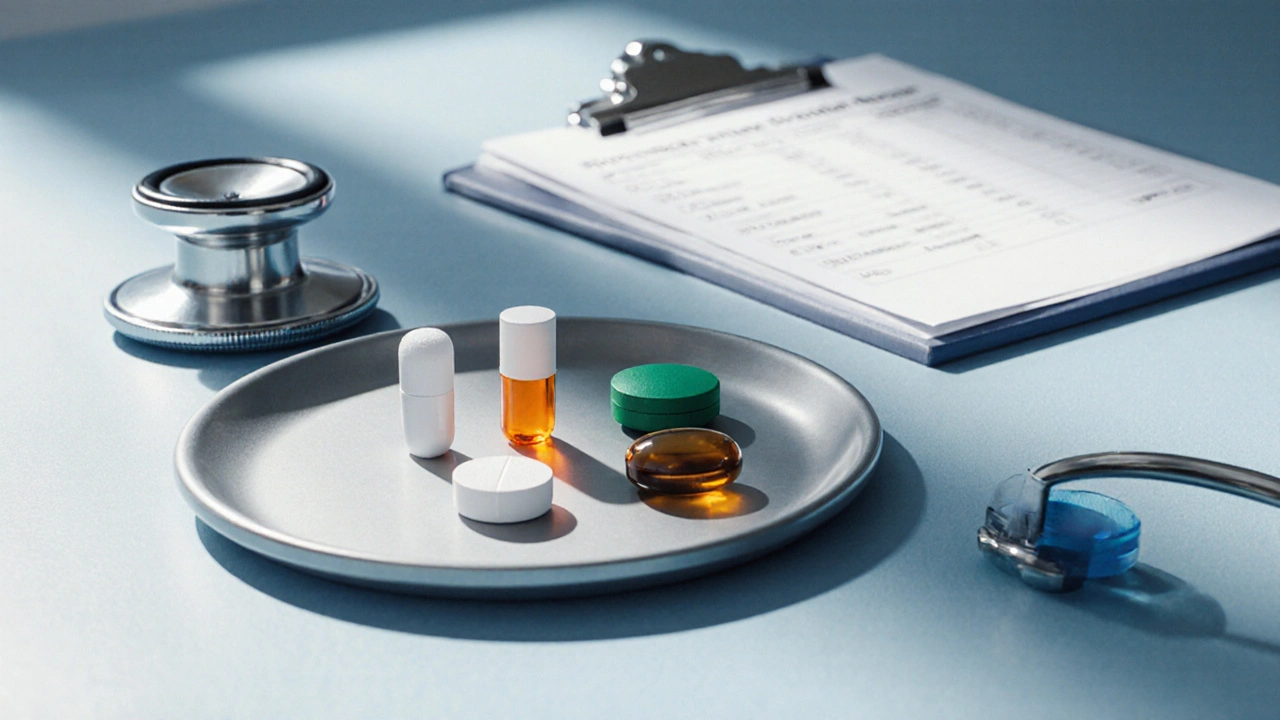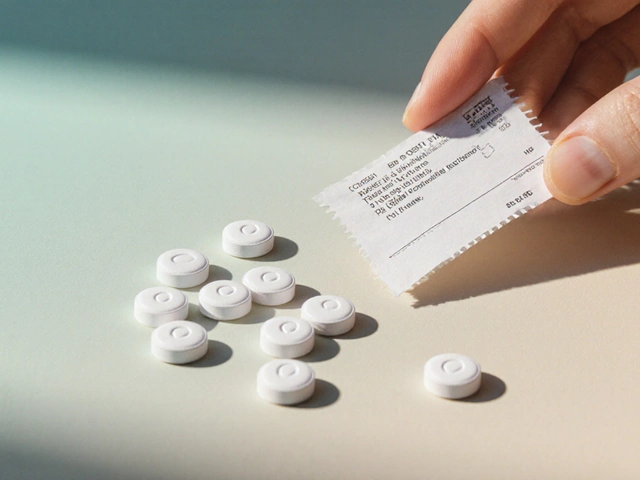Loop Diuretic Selector
Recommended Diuretic Options
When treating fluid overload, Furosemide is a loop diuretic that promotes rapid excretion of sodium and water by inhibiting the Na‑K‑2Cl transporter in the thick ascending limb of the nephron. It’s been a workhorse in hospitals and clinics since the 1960s, handling everything from congestive heart failure to severe hypertension.
But you’re not limited to a single pill. Other loop diuretic agents share the same kidney target but differ in potency, duration, and side‑effect profile
How Furosemide Works
Furosemide binds to the luminal side of the Na‑K‑2Cl cotransporter, stopping it from re‑absorbing these electrolytes. The resulting osmotic gradient pulls water into the urine, leading to a brisk diuresis. Because the effect begins within 30‑60 minutes after an oral dose, doctors can quickly gauge response and adjust therapy.
Main Alternatives to Furosemide
Each alternative tweaks the basic loop‑diuretic formula in a way that can be advantageous for specific patients.
- Torsemide offers a longer half‑life and may cause fewer sudden‑drop blood pressure episodes
- Bumetanide is roughly 40 times more potent than furosemide, making it useful when high‑dose furosemide would be unwieldy
- Ethacrynic acid is the only non‑sulfonamide loop diuretic, allowing use in patients allergic to sulfa drugs
- Hydrochlorothiazide is a thiazide diuretic, not a loop, but often paired with furosemide for resistant hypertension
- Metolazone acts on the distal tubule and stays effective even when kidney function falls below 30mL/min

Head‑to‑Head Comparison
| Diuretic | Typical Oral Dose | Onset (oral) | Duration | Renal Safety | Common Indications |
|---|---|---|---|---|---|
| Furosemide | 20‑80mg | 30‑60min | 6‑8h | Good | Edema, HF, Hypertension |
| Torsemide | 5‑20mg | 30‑60min | 8‑12h | Very good | Edema, HF |
| Bumetanide | 0.5‑2mg | 15‑30min | 4‑6h | Good | Severe edema |
| Ethacrynic acid | 50‑200mg | 30‑60min | 4‑6h | Moderate | Patients with sulfa allergy |
| Hydrochlorothiazide | 12.5‑50mg | 2‑4h | 12‑24h | Excellent | Mild hypertension |
Choosing the Right Diuretic for Your Situation
Think of your decision like picking the right tool from a toolbox. If you need a rapid, strong diuresis for acute pulmonary edema, Furosemide remains the go‑to because of its predictable knock‑down of fluid within an hour. For patients who experience sharp drops in blood pressure or who have a history of ototoxicity with high‑dose furosemide, Torsemide’s smoother pharmacokinetic curve can be kinder.
Bumetanide shines when you need a compact dose - hospitals often prefer it for patients on IV pumps where volume matters. Ethacrynic acid steps in only when sulfa‑based loops are contraindicated, but its narrower therapeutic window means close monitoring.
When kidney function is slipping below a creatinine clearance of 30mL/min, Metolazone retains its effect where classic loops lose potency. Pairing a low dose of furosemide with a thiazide like Hydrochlorothiazide can overcome diuretic resistance, especially in refractory hypertension.

Safety, Side Effects, and Drug Interactions
All loop diuretics share a core side‑effect profile: electrolyte loss (especially potassium, magnesium, calcium), dehydration, and a potential rise in uric acid. Furosemide and Bumetanide are most notorious for causing ototoxicity when given in very high IV doses, particularly in patients with existing hearing issues.
Torsemide appears to cause fewer electrolyte swings, likely because of its longer, steadier excretion. Ethacrynic acid adds a risk of allergic reactions and can be a bit harsher on the kidneys, so baseline renal labs are a must before starting.
Drug interactions to watch for include:
- Non‑steroidal anti‑inflammatory drugs (NSAIDs) - they blunt the diuretic response.
- ACE inhibitors or ARBs - the combination can cause profound hypotension but is often intentional in heart‑failure regimens.
- Lithium - loop diuretics raise lithium levels and may precipitate toxicity.
- Digoxin - low potassium from any loop increases digoxin’s arrhythmogenic potential.
Practical Tips for Patients
- Take your dose in the morning to avoid nocturia.
- Stay hydrated, but follow your doctor’s fluid‑restriction advice exactly.
- Check weight daily; a loss of 1-2kg in a day often signals effective diuresis.
- Ask for a potassium supplement or a potassium‑rich diet if you’re on high‑dose loops.
- Report any ringing in the ears or sudden hearing loss immediately.
Frequently Asked Questions
Can I switch from furosemide to torsemide without a doctor’s supervision?
No. Although both are loop diuretics, their dosing isn’t interchangeable. A doctor will calculate an equivalent dose and monitor electrolytes.
Why do some patients develop hearing problems with furosemide?
High intravenous concentrations can damage the inner ear’s hair cells. The risk rises with rapid infusion, high total daily dose, and pre‑existing ear disease.
Is ethacrynic acid a good first‑line choice?
Usually not. It’s reserved for patients who can’t tolerate sulfonamide loops because it has a tighter safety margin and can be harder to dose.
How does a thiazide diuretic help when combined with a loop?
Thiazides act farther down the nephron, catching the sodium that loops miss. The combo often overcomes resistance and yields a stronger overall blood‑pressure drop.
What monitoring is required after starting a new loop diuretic?
Baseline and follow‑up labs for potassium, magnesium, calcium, creatinine, and blood urea nitrogen are standard. Blood pressure and weight should be checked daily for the first week.



 Medications
Medications





Macy Weaver
October 7, 2025 AT 14:23Furosemide really is the workhorse when you need to dump fluid fast. In practice I’ve seen it pull down a 90‑lb weight gain in under 24 hours for acute pulmonary edema. For patients who can’t tolerate the rapid shift, switching to a longer‑acting loop like torsemide can smooth out the blood‑pressure dip.
James McCracken
October 11, 2025 AT 01:43Ah, the endless parade of loop diuretics, each promising to be the panacea for the other’s shortcomings. One could argue that the real art lies in knowing when not to use any of them, especially in a healthcare system that loves to medicate everything. Yet the literature insists that torsemide’s half‑life makes it the 'superior' choice, a claim that feels more marketing than medicine. Still, the data on reduced ototoxicity is worth a glance.
Evelyn XCII
October 14, 2025 AT 13:03Sure, because swapping diuretics is as casual as changing shoes.
Suzanne Podany
October 18, 2025 AT 00:23Let’s keep in mind that patient education matters just as much as the drug choice. Explaining the importance of morning dosing can prevent those dreaded nighttime bathroom trips. And when you pair a loop with a thiazide, monitor electrolytes closely; it’s a team effort between clinician and patient.
Nina Vera
October 21, 2025 AT 11:43Whoa! Reading about bumetanide being 40 times more potent made my head spin – it’s like the rocket fuel of diuretics! If you’ve ever tried to push a massive dose of furosemide, you know the volume can be a nightmare. That’s why a tiny bumetanide tablet feels like a miracle for the most stubborn edema. And don’t even get me started on the drama of choosing ethacrynic acid when sulfa allergies show up – pure soap‑opera material!
Christopher Stanford
October 24, 2025 AT 23:03Honestly, the hype around bumetanide’s potency ignores the fact that its narrow therapeutic window can trip you up faster than a bad spreadsheet. Most clinicians end up defaulting to furosemide because the dosing is predictable, even if it means a bigger pill burden. The supposed ‘rocket fuel’ label feels like an over‑dramatic sales pitch, not a clinical reality.
Steve Ellis
October 28, 2025 AT 10:23From a coaching perspective, think of diuretics as tools in a toolkit – each suited for a specific job. If a patient’s BP drops too sharply on furosemide, torsemide’s steadier profile can keep them steady. And when resistance kicks in, adding a thiazide is the classic combo that often breaks the stalemate.
Jennifer Brenko
October 31, 2025 AT 21:43While the comparative tables are thorough, they omit a critical perspective: the cost and availability of these agents in different healthcare systems. In many regions, the choice is dictated not by pharmacodynamics but by what the pharmacy can supply. A balanced analysis should account for these pragmatic constraints.
Harold Godínez
November 4, 2025 AT 09:03Good point about supply issues, but also note that the dosing notation in the table could use a bit more consistency – sometimes mg, sometimes mg/kg. A clear standard helps avoid prescription errors.
Sunil Kamle
November 7, 2025 AT 20:23It is indeed commendable how the article delineates the nuances of each loop diuretic, providing a pragmatic framework for clinicians. However, one might question whether the emphasis on renal safety sufficiently integrates the emerging data on long‑term cardiovascular outcomes. In any case, the systematic approach remains a valuable reference.
Michael Weber
November 11, 2025 AT 07:43From a precise standpoint, the electrolyte disturbances associated with loop diuretics demand vigilant monitoring, especially potassium and magnesium levels. Failure to adjust for concurrent ACE inhibitor therapy can precipitate profound hypotension. Moreover, the interaction with lithium underscores the need for interdisciplinary coordination.
Blake Marshall
November 14, 2025 AT 19:03Yo, you’re right but honestly most docs just write a script and forget the labs. If you’re not gonna check the numbers, why even bother with the fancy loops?
Shana Shapiro '19
November 18, 2025 AT 06:23The emotional toll on patients navigating frequent weight checks and dietary restrictions cannot be overstated. A compassionate approach, reminding them that a modest 1‑2 kg loss per day signals therapeutic progress, can empower them during a stressful period. When hearing changes appear, prompt reporting is crucial to prevent irreversible damage.
Jillian Bell
November 21, 2025 AT 17:43One could speculate that the pharmaceutical push for newer loops aligns with a covert agenda to keep us dependent on ever‑more expensive meds, a classic example of the medical‑industrial complex at work. Consider how the subtle shift from furosemide to torsemide is packaged as ‘advanced therapy,’ yet the underlying mechanisms remain untouched. It raises the question of whether we are truly advancing patient care or merely feeding a profit‑driven narrative.
Lindsey Bollig
November 25, 2025 AT 05:03If you’re trying to figure out which diuretic to start with, the first thing to ask yourself is what the primary goal is – rapid fluid removal or long‑term blood pressure control. Furosemide is unbeatable for getting rid of a ton of fluid fast, especially in acute pulmonary edema where every hour counts. However, that same speed can be a double‑edged sword, because the sudden shift can drop blood pressure and even hurt your ears if you’re not careful with the dose. Torsemide steps in here with a smoother onset and a longer half‑life, which means fewer ups and downs in blood pressure. For patients who have a history of ototoxicity or who need to stay on a loop for weeks, torsemide often feels gentler. If the patient’s kidneys are struggling, bumetanide’s potency can be useful, but you have to respect its narrow therapeutic window. Ethacrynic acid should only come into play when a sulfa allergy blocks the use of the other loops, and even then you’ll want to watch renal labs closely. Metolazone is the dark horse that shines when creatinine clearance slips below 30 mL/min, because it works downstream in the nephron. Pairing a low dose of a loop with a thiazide like hydrochlorothiazide is a classic trick to break diuretic resistance and get that extra push on blood pressure. Don’t forget that NSAIDs can blunt the effect of any loop you choose, so advise patients to limit those if they can. Also, when you add an ACE inhibitor or ARB, be ready for a possible dip in blood pressure, but that combo is often intentional in heart‑failure regimens. Lithium levels will climb on any loop, so if your patient is on mood stabilizers, you’ll need to monitor serum lithium closely. And always keep an eye on potassium – a drop can set the stage for dangerous digoxin arrhythmias. In practice, I start with furosemide for most acute cases, switch to torsemide for stability, and add metolazone when renal function declines. The key is to tailor the regimen, check labs daily in the first week, and involve the patient in the weight‑tracking game – that’s how you turn a complex pharmacology list into real‑world results.